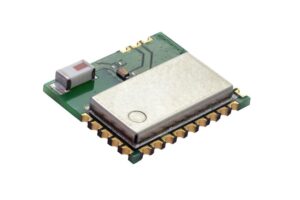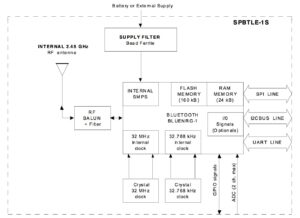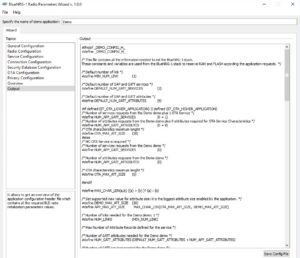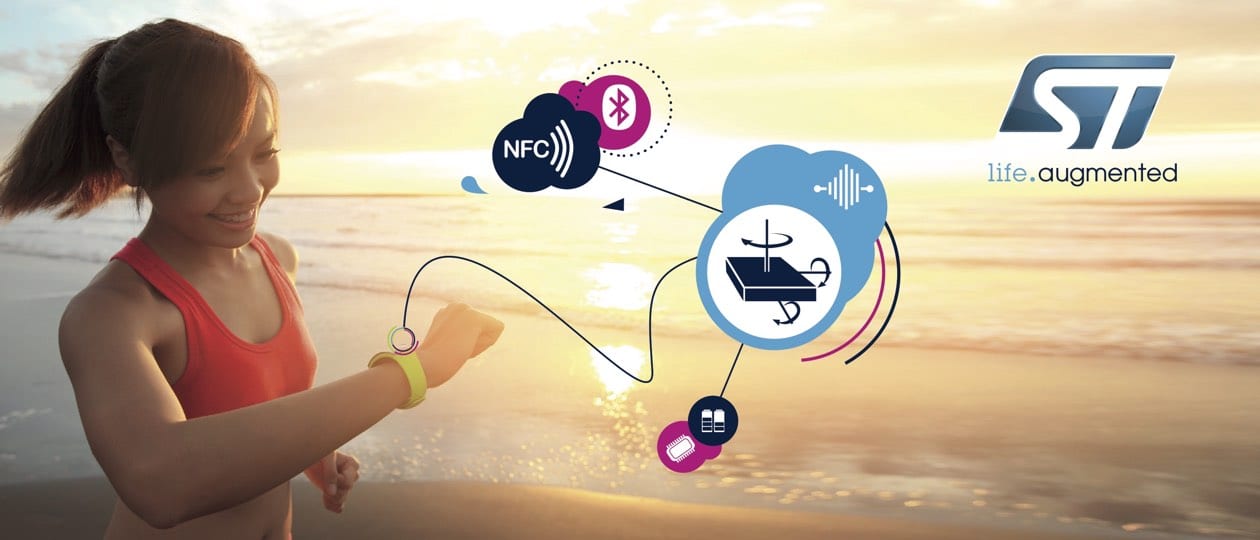In honor of the ST Developers Conference 2017 being held today, ST is launching the all-in-one Bluetooth 4.2 module SPBTLE–1S designed to significantly speed up prototyping and developments, while reducing costs. As the Life.Augmented Blog was preparing for this event, we delved into the popularity and challenges of Bluetooth Low Energy (LE or BLE) since Bluetooth 5, and Bluetooth mesh, build upon this standard. The reason behind the success of Bluetooth LE is simple: the bandwidth available at such a low power consumption opens the industry to new products and ideas. However, there’s a truth that remains self-evident no matter the years of experience or the level of expertise of the engineers on a team: integrating any sort of RF system is hard and challenging work.
This is why ST first launched BlueNRG–1, a BLE System-on-Chip that consumes very little energy and takes some of the complexity out of the equation. The component is quite a feat of engineering as it reduced the operating voltage needed from 2 V on the previous generation to 1.7 V while offering a complete network processor and a microcontroller (MCU) based on a Cortex-M0 running at 32 MHz. As a result, designs without a host MCU could benefit from a complete solution able to efficiently run application code thanks to a copious 160 KB of Flash memory and cryptographic acceleration.
SPBTLE–1S: Hardware and Certifications Included

Today, ST goes one step further with the SPBTLE–1S. The module measures only 11.5 mm x 13.5 mm x 2 mm and includes the BlueNRG–1 SoC as well a power supply filter, the oscillators for the MCU, the baluns, the filters used for matching networks and reducing harmonics, and even the ceramic antennas. In the past, teams that didn’t have large RF departments, like the one behind the Snuza Pico, ended up choosing a BlueNRG chip and its compatible balun, like the BALF-NRG–01D3, because it meant they didn’t have to outsource the design. They had all the components and only needed outside help to tune the system. The SPBTLE–1S solves that last hurdle by offering a tuned system.
ST released an all-in-one BLE solution in the past, the SPBTLE-RF, but it didn’t integrate a Cortex MCU, it was compatible with Bluetooth 4.1, and its transmit power was +4 dBm, whereas the new module is compatible with 4.2 and can achieve +5 dBm. Furthermore, the SPBTLE–1S has already passed the FCC, IC, CE, and SRCC certifications for the United States, Canada, the European Union, and China respectively. As a result, any company that integrates the module has a much easier path toward certifying their product since ST took care of the biggest challenges.
SPBTLE–1S: All Things to All Engineers

The SPBTLE–1S isn’t only practical it is also versatile. Its range of operating supply voltage from 1.7 V to 3.6 V means the same module accepts a wide variety of power sources, from AAA batteries to coin cells. The component is also compatible with numerous interfaces, such as UART, SPI, or I2C, which is a significant advantage for designers who can work with the peripherals they already have, instead of needing to order new parts or start a new design simply because they don’t have an appropriate interface.
Finally, there are different versions of the BlueNRG–1, one of them even certified for automotive applications. Furthermore, the SoC even includes a PDM stream processor for audio applications. Hence, the SPBTLE–1S can be the first step in designing a broad range of products since teams can use the code and applications they’ve started to develop and just order the BlueNRG part that is most relevant for their use case.
Download, Set, Go!

The quickest and easiest way to start developments is to obtain the STEVAL-IDB007V1M evaluation board, which includes the SPBTLE–1S, a 3D digital accelerometer and 3D digital gyroscope (LSM6DS3), as well as a barometer that’s also a thermometer (LPS25HB). It has Arduino connectors to plug additional boards, a battery holder to test mobile application, and a USB port to very quickly load firmware or debug the system. All engineers have to do to get started is download the STSW-BLUENRG1-DK software pack, which includes a GUI, demonstration programs, drivers, and source code (“/Program Files (x86)/STMicroelectronics/BlueNRG–1_2 DK 2.5.0”).
Among the many demo applications, there’s the BLE Chat that very quickly and easily implements a two-way communication system with BlueNRG components, one acting as a client and the other as a server. Needless to say, that this is the kind of binaries that can jump-start any project in no time. There’s even a Flasher to program the SoC once developers are ready to take their design to the next level, and a wizard can create a configuration file to setup the RF component. This means that ST doesn’t only offer an already tuned all-in-one solution, but the company even holds the hands of engineers through the configuration process. The wizard provides details on the parameters and then outputs a header file with all the constants and variables already pre-programmed to initialize the BlueNRG–1 stack.
The SPBTLE–1S is already in mass production and the STEVAL-IDB007V1M will be available within one month in our distribution channel partners at an RRP of approximately USD45.
